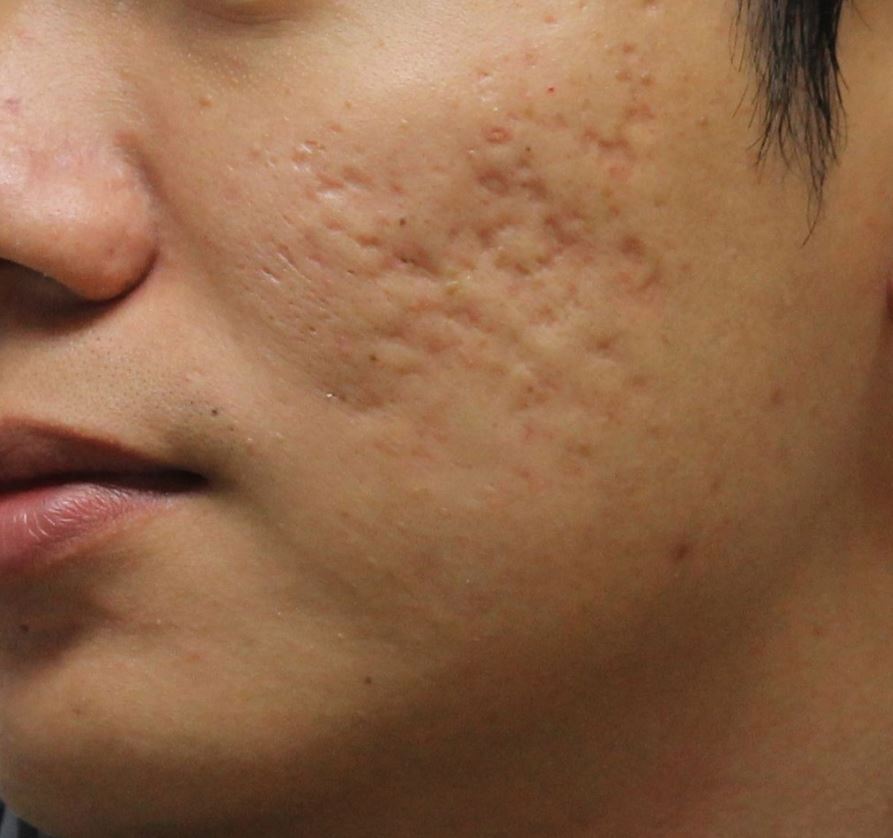Some people who had acne when they were teenagers today have unpleasant marks on their skin. We refer to those marks as acne scars or acne scarring. There are different types of acne scars. When we meet somebody new, we tend to look at their faces first. If there are marks on their face, we usually notice them.

Having unpleasant scars on your face and forehead can undermine your self confidence significantly. Millions of people across the world regularly search online for ways to get rid of acne scarring.
What is acne?
When our hair follicles become plugged with dead skin cells and oil we get pimples (acne) which typically appear on our forehead, face, shoulders, upper, back, and chest. Doctors refer to this oil as sebum.
When the follicles are plugged with sebum, a bacterium called Propionibacterium acnes (P. acnes) becomes more aggressive, causing inflammation and an accumulation of pus.
Put simply; acne causes spots, and oily skin. Sometimes, the person’s skin is hot and may even be painful to touch.
It is most commonly caused by the changes in a person’s hormone levels during adolescence; specifically, during puberty.
In most cases, the pimples and bumps gradually heal and disappear. In severe cases, however, there can be permanent marks on the skin. .
Types of acne scars
There are different types of acne scars:
Ice pick scars
Appropriately named, these acne scars are small. However, they go deep into the skin.
Boxcar scars
These are the irregularly shaped scars. They look like oval or round depressions or craters in the skin. Boxcar scars are wider than ice pick scars, with sharp vertical edges.
Rolling scars
This type is caused by the formation of bands of scar tissue under the skin, which gives the skin’s surface a rolling (uneven) appearance.
Hyperpigmentation
In fact, hyperpigmentation is not technically a kind of scarring. However, it is commonly included in this type of list. Pigmentation is the natural coloring of plant or animal tissue. Hyper, in this context, means excessive.
Hyperpigmentation refers to dark marks on the skin cause by the overproduction of melanin. Melanin gives our skin and hair their color. People with acne during their teenage and young adult years may experience hyperpigmentation in the affected areas afterwards – when the spots and pimples have gone. It is an aftermath of inflammation.
Treatments for acne scarring
Several treatments are currently available. Lets look at some of them:
Home Remedies
There are several to choose from, including lemon juice, honey, Aloe Vera, olive oil, baking soda, and even vinegar. Home remedies are cheap, which is probably why they are so popular.
However, nobody knows how effective they are. Researchers need to carry out comprehensive studies (trials) to find out.
Dermabrasion
In this skin-resurfacing procedure, a doctor uses a rapidly rotating device that sands the top layers of the patient’s skin. After the procedure, the skin usually grows back younger looking and smoother.
The American Society for Dermatologic Surgery says the following about dermabration for acne scars:
“The treated area typically appears smoother and refreshed. Outcomes can be dramatic and long-lasting.”
Chemical Peel
This procedure, like dermabrasion, involves removing the top layer of the patient’s skin. However, in this case a chemical, specifically, an acid, is used. The most common peeling agents are phenol, salicylic acid, mandelic acid, pyruvic acid glycolic acid, lactic acid, Jessner solution, and trichloroacetic acid.
Studies have not produced any compelling evidence that chemical peels work.
Fillers
This involves injecting collagen or fat into the affected areas. They fill out the acne scars and puff out the skin, making the scars less noticeable.
The pro to this is that many people have said that it does, in fact, work. However, the body eventually absorbs the fillers. It is, therefore, not a permanent solution.
Surgery
Surgery to remove scars involves cutting them out or loosening them. In some procedures, the patient may need stitches. Skin grafts may also be used.
Surgery is an effective option, however, it is not cheap. Also, there is some risk related to any kind of surgey.
PRP (Platelet-Rich Plasma Therapy)
This is a procedure that involves taking out some of the client’s blood and then separating out the platelet-rich plasma from it. This is then injected into the affected areas to promote the skin’s ability to heal itself, thereby getting rid of the scars.
Although this is a straightforward and rapid procedure, there is no proof whatsoever that it actually works!
Laser Therapy
If you are looking for a procedure that permanently removes acne scarring, laser treatment is definitely worth considering. Apart from being extremely popular, it is also recommended by most doctors.
A laser beam, i.e., ray of concentrated light, is used in one of two possible ways:
- The top layers of the patient’s skin are removed.
- The laser is used to trigger new skin formation, which hopefully covers the scar tissue.
The pros are that it’s a fast procedure and fairly inexpensive compared to other treatments. It is also proven to work and most people who have it done are happy with the results.
The only con is that there can be some swelling and redness in the target area for a few days. Laser therapy does appear to be the best solution for treating acne scars today, though!

